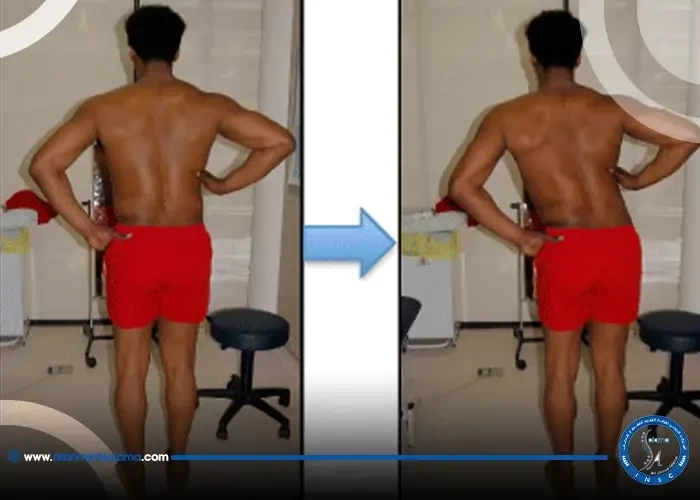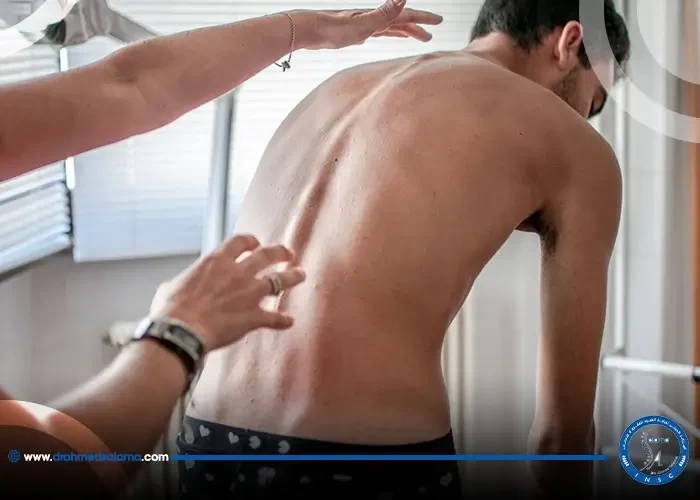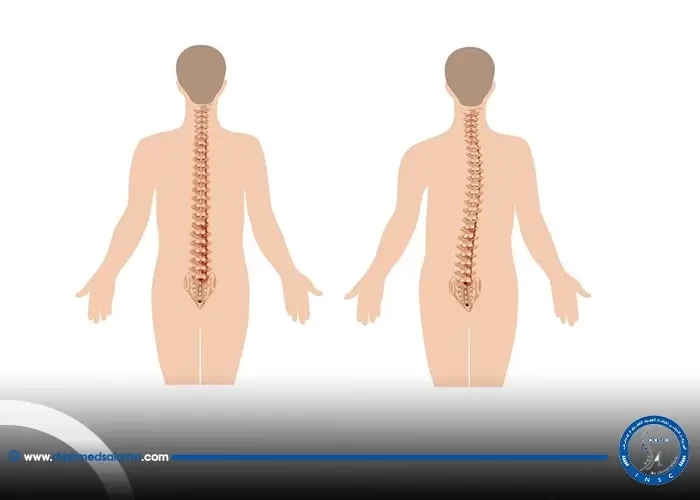Nasr City, 52 El Tayaran Street, in front of the Health Insurance Hospital

Symptoms of spinal cord compression

Symptoms of spinal cord compression are serious health problems that should not be ignored. They can begin with pain and numbness in the extremities and end with complications that can affect mobility and quality of life. What is the spinal cord and what is its vital function in the body? Is spinal cord compression dangerous? What are the symptoms of spinal cord inflammation?
In this article, we will learn about the symptoms of spinal cord compression, its causes, and how to treat it, including treating a disc compressing the spinal cord. We will also discuss the success rate of spinal cord surgery. We will also explain why Dr. Ahmed Ibrahim Salama, a consultant neurosurgeon and spine surgeon, is a leading option for treating these conditions with precision and expertise. Just keep reading to the end.
Symptoms of spinal cord compression
Symptoms of spinal cord compression appear in varying degrees from one case to another, depending on the cause of the compression. Addressing these symptoms early helps prevent serious complications. The most prominent of these symptoms include:
Pain or stiffness in the neck or lower back.
Burning pain that may extend to the buttocks, arms, or even legs.
Weakness, cramping, or numbness in the extremities.
Loss of sensation in the feet.
Difficulty coordinating fine motor movements in the extremities.
Loss of sexual ability.
In complex cases, where pressure from the lumbar vertebrae significantly increases on the spinal cord, serious complications known as cauda equina syndrome may occur. This rare but urgent condition leads to more severe and dangerous symptoms, including:
Loss of sensation or numbness in the buttocks and inner thighs (saddle area).
Severe weakness or paralysis in the legs.
Urinary incontinence or loss of bowel control.
Severe lower back pain radiating to the legs.
Difficulty walking or standing due to nerve weakness.
Sexual dysfunction due to nerve damage.
Because dealing with the symptoms of spinal cord compression requires high medical expertise and skill, don't hesitate to consult Dr. Ahmed Ibrahim Salama, a consultant neurosurgeon and spine surgeon, to ensure an accurate diagnosis and effective treatment tailored to your condition.
What is the spinal cord?
The spinal cord is a long, thin neural tube that extends from the brain down through the spine within a special channel known as the spinal canal. Its structure resembles a thick electrical cable that transmits nerve signals between the brain and the body. Although protected by the spine, the spinal cord remains a delicate structure, and any injury or pressure on it may lead to symptoms of spinal cord compression, such as loss of sensation or the ability to move.
Because the health of the spinal cord cannot be delayed, don't hesitate to seek the expertise of Dr. Ahmed Ibrahim Salama, who will guarantee you an accurate diagnosis and the safest and most effective treatment plan.
The Function of the Spinal Cord
Now that we know what the spinal cord is, what is it? It's worth clarifying the vital role the spinal cord plays in the body. Its function is to serve as a major communication channel between the brain and the rest of the body. It transmits nerve impulses from the brain to the muscles and limbs, and in turn, relays sensory signals such as pain, temperature, and touch for the brain to process. Beyond that, its role also controls some immediate responses known as reflexes, such as quickly withdrawing the hand when touching a hot object to protect the body from injury. Therefore, any compression or injury to the cord may lead to symptoms of spinal cord compression, which may impair movement and sensation.
Because early diagnosis and appropriate therapeutic intervention are key to protecting your spine, consulting a trusted doctor like Dr. Ahmed Ibrahim Salama is essential to obtaining specialized care and accurate treatment solutions.
Causes of Spinal Cord Compression
The symptoms of spinal cord compression are not limited to a single cause. There are many causes that may lead to its occurrence and directly impact the spinal cord's ability to perform its normal function. The most prominent of these causes include:
Bone injuries such as fractures, vertebral displacement, or abnormal growth, especially in cases of osteoporosis or cancer.
Tumors, whether benign or malignant, may compress the spinal cord.
An abscess resulting from the accumulation of pus around or within the spinal cord may cause dangerous pressure.
Slipped disc, where a herniated disc may compress the nerve roots or the spinal cord itself.
Narrowing of the spinal canal due to aging or abnormal bone growth.
Hematomas in or around the spinal cord resulting from injury, vascular dysfunction, or the use of blood thinners.
Spinal deformities such as scoliosis, kyphosis, or lordosis.
With the variety of causes and overlapping symptoms, choosing the right doctor to diagnose and effectively manage the condition remains essential for successful treatment. Therefore, we recommend consulting Dr. Ahmed Ibrahim Salama for an accurate assessment and a comprehensive treatment plan that guarantees the best results.
Is spinal cord compression dangerous?
Yes, spinal cord compression is a serious condition that directly impacts quality of life. Neglecting treatment can lead to severe complications such as weakness or loss of movement, sensory disturbances, or even problems with bladder and bowel control. The risk increases the later the diagnosis is made, especially if symptoms of spinal cord compression persist, such as chronic pain, numbness, or loss of balance. Therefore, prompt medical intervention through a specialist consultation is essential to avoid complications and restore vital functions.
Spinal Cord Compression Treatment
Dealing with spinal cord compression depends on the severity of the condition and its associated symptoms. The treatment plan aims to reduce pain, improve mobility, and limit complications resulting from persistent symptoms of spinal cord compression. The most prominent treatment methods include:
Surgery: Surgical intervention is the primary option for relieving pressure, whether by relieving compression or stabilizing the vertebrae with rods or screws, especially in emergency cases or cases that have not responded to conservative treatment.
Draining Abscesses or Hematomas: If a compressed abscess or hematoma is present, it is drained surgically or with a needle, with antibiotics prescribed if necessary.
Corticosteroids: In some cases, they are given intravenously to reduce swelling around the spinal cord and relieve nerve compression.
Radiation Therapy: Used in cases of tumors causing compression, and sometimes combined with surgery.
When is Immediate Surgical Intervention Required?
Immediate surgical intervention is necessary in cases of spinal cord compression if serious symptoms appear that indicate a permanent threat to nerves or loss of neurological function. The most prominent of these are:
Loss of control over urination or defecation (urinary or fecal incontinence).
Severe weakness or sudden paralysis of the extremities.
Severe, progressive pain that does not improve with medication or conservative treatment.
Significant loss of sensation, especially in the saddle area (buttocks and inner thighs).
A tumor or abscess pressing on the spinal cord requires urgent removal.
In these situations, urgent surgery is necessary to relieve pressure and prevent permanent damage or loss of motor and sensory functions. This is where Dr. Ahmed Ibrahim Salama comes in, with his extensive experience in neurosurgery and his use of the latest technologies to ensure the highest success rates and patient safety.
Spinal cord surgery success rate
The success rate of spinal cord surgery reaches 95%. Spinal cord surgery is a delicate procedure with high success rates, especially when performed by a physician with extensive experience in such cases. However, the success rate may vary from patient to patient depending on several key factors, including:
The severity of the condition and the severity of the pressure on the spinal cord.
The speed of medical intervention and treatment of the symptoms of spinal cord compression.
The patient's general health condition, such as the presence of chronic diseases or immunodeficiency.
The patient's adherence to physical therapy and rehabilitation after surgery.
The experience of the surgeon and his medical team and the techniques used during the procedure.
Therefore, choosing an experienced doctor is a necessary step to achieve the best success rate for spinal cord surgery and minimize complications. Therefore, do not hesitate to consult Dr. Ahmed Ibrahim Salama for comprehensive care and guaranteed results.
Treatment of a Disc Compressing the Spinal Cord
Treatment of a disc compressing the spinal cord depends on relieving pressure, improving the patient's mobility, and reducing pain. The treatment approach varies depending on the severity of the compression and the symptoms of spinal cord compression experienced by each patient. Treatment methods include:
Medications: such as nonsteroidal anti-inflammatory drugs (NSAIDs) and cortisone injections to reduce swelling, in addition to muscle relaxants or strong painkillers in severe cases.
Physiotherapy sessions: These include specialized exercises to strengthen the back, abdominal, and leg muscles under the supervision of a specialist, helping to support the spine and reduce pressure on the spinal cord.
Surgery: This is performed to remove the source of the pressure, whether by removing a laminectomy, removing bone spurs, or even replacing damaged discs.
With a variety of treatment options, an accurate diagnosis and developing an appropriate plan with your doctor remain essential steps to regaining a normal lifestyle. Therefore, don't hesitate to book your consultation with Dr. Ahmed Ibrahim Salama to determine the appropriate treatment for your condition.
Symptoms of Cervical Vertebral Compression on the Spinal Cord
Cervical vertebrae compression on the spinal cord causes a range of symptoms that may develop gradually and affect movement and sensation. The most prominent symptoms of spinal cord compression in the cervical vertebrae area include:
Persistent neck pain extending to the shoulder or arms.
Weakness or numbness in the hands and fingers.
Difficulty with balance and walking.
Neck stiffness and decreased flexibility.
Loss of strength in the upper or lower extremities.
Recurring headaches, especially in the back of the head.
Symptoms of Spinal Cord Inflammation
Symptoms of spinal cord inflammation appear when the nerve tissue responsible for transmitting signals between the brain and the body is affected. This can lead to varying motor and sensory problems, causing symptoms such as severe back or neck pain, weakness or numbness in the extremities, loss of balance and difficulty walking, as well as bladder or bowel control disturbances.
Because dealing with these neurological conditions requires extensive medical expertise and skill, consulting Dr. Ahmed Ibrahim Salama, a physician specializing in treating symptoms of spinal cord compression, is the right choice for accurate diagnosis and effective treatment.
Why Choose Dr. Ahmed Ibrahim Salama?
When it comes to accurately diagnosing and treating spinal cord compression symptoms using the latest methods, Dr. Ahmed Ibrahim Salama, a consultant neurosurgeon and spine surgeon, stands out for his extensive experience in diagnosing the most delicate cases and developing comprehensive treatment plans tailored to each patient.
Dr. Ahmed Ibrahim Salama also excels in utilizing the latest medical technologies, both in minimally invasive surgical interventions and non-surgical treatments, giving patients a better chance of a speedy recovery and minimizing complications. He is also keen to educate patients on the details of their condition and explain the available treatment options clearly and transparently, enhancing their confidence and psychological comfort during their treatment journey.
In conclusion, the symptoms of spinal cord compression are warning signs that should never be ignored. They may begin with minor pain or numbness in the extremities, but they can develop into more serious neurological and motor problems if not treated promptly. With the expertise of Dr. Ahmed Ibrahim Salama, a consultant neurosurgeon and spine surgeon, you can rest assured that you are in safe hands. He ensures accurate diagnosis using the latest medical methods and develops a comprehensive treatment plan tailored to each case. Don't let your symptoms worsen; book your consultation now to regain your quality of life with confidence and security
How do I know if my spinal cord is damaged?
Spinal cord damage manifests itself through clear symptoms such as weakness or numbness in the extremities, loss of motor control, difficulty with balance, or problems with urination and defecation.
How do I know if a disc is compressing a nerve?
A disc compressing a nerve causes severe pain that radiates from the back to the leg or arm, along with numbness or tingling and weakness in the muscles associated with the compressed nerve. If symptoms persist, it is recommended to consult a specialist such as Dr. Ahmed Ibrahim Salama to determine the appropriate treatment.






